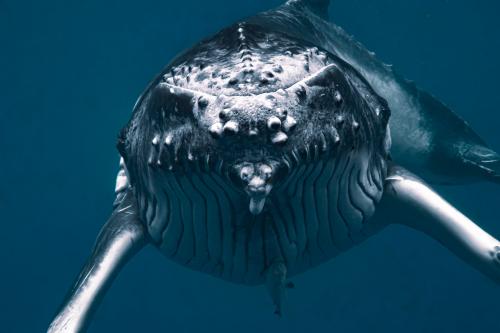Many facets of BOEM’s science and monitoring work use Passive Acoustic Monitoring (PAM) technology.
PAM is a useful tool for:
- Observing the presence of vocalizing species
- Measuring the received levels of anthropogenic sound sources
- Quantifying the levels and patterns of naturally occurring sounds, including those from marine life
During offshore wind development, PAM will be employed for several purposes:
- Short-term recordings will measure sound levels from pile-driving operations and from operational wind turbines.
- During construction, real-time PAM will be used to alert operators when vocalizing species are nearby.
- For several years pre- and post-construction, archival PAM systems will record the presence of vocalizing marine mammals and fish.
BOEM has worked with several stakeholders to establish a long-term regional PAM Network in the Atlantic Ocean to centralize acoustic data and share them alongside other data streams. This network will allow for a more robust analysis and greater understanding of where animals are and, ideally, insights about what they are doing. The effort will initially focus on whether there a measurable change in baleen whale distributions due to offshore wind development or another stressor, but additional species may also be recorded and analyzed. Working with staff in BOEM’s Office of Renewable Energy Programs, the CMA hosted several workshops to gather input from key stakeholders on this PAM network. The workshop reports can be found at the links below.
Given the many changes that are already occurring in the northwest Atlantic Ocean, scientists will need to collect other oceanographic data – alongside PAM data – to determine the cause of any detected change. BOEM plans to collate oceanographic data collected by many entities along the east coast (including offshore wind lessees), and eventually incorporate these data, along with PAM data, into a larger multivariate analysis.
In addition to using PAM for offshore wind development and monitoring, BOEM has funded several studies that have utilized PAM to answer important questions about the marine environment and life within it. Working with BOEM’s Environmental Studies Program, the CMA has developed the BOEM Acoustics Science Strategy (BASS) to ensure current and future informational needs are addressed by taking a proactive approach to addressing knowledge gaps.
Draft Finding for PAM Activities on the Atlantic OCS Available
In preparation for deploying PAM units throughout the Atlantic OCS, BOEM has made a Draft Finding of no historic properties affected. The draft document is available for public review and comment at: Draft Finding of No Historic Properties Affected for Passive Acoustic Monitoring Activities on the Atlantic Outer Continental Shelf. Please submit comments to BOEM’s Center for Marine Acoustics at boemacoustics@boem.gov by April 26, 2025.
Establishing a PAM network entails acquiring and deploying passive acoustic equipment and then analyzing the acoustic data to assess anthropogenic noise and species presence. BOEM has identified potential areas where units may be deployed and will utilize existing survey data to avoid any archaeological resources. For areas that have not been previously surveyed, BOEM will avoid affecting any potential historic properties by imposing specific requirements of the deployment teams, including targeted pre-deployment surveys using de minimis sources like echosounders.
POWERON: Partnership for an Offshore Wind Energy Regional Observation Network
The Partnership for an Offshore Wind Energy Regional Observation Network (POWERON) is an innovative public-private partnership between BOEM and offshore wind lessees designed to maximize the quality and consistency of collected scientific data in lease areas while conserving and optimizing resources.
BOEM requires offshore wind lessees to conduct long-term PAM on their lease areas to measure sound levels and monitor for the presence of vocalizing marine species like whales and dolphins. With POWERON, lessees can make annual contributions to BOEM to have their long-term PAM requirements fulfilled by an approved third party. Their annual contribution – which is scaled by the size of the lease area – will cover the cost of instrumentation, vessel time, data processing, and analysis.
POWERON has several benefits:
- Data consistency – Researchers will use similar instrument types, consistent calibration, and standard methods for data processing, which will lead to more robust results.
- Conserving/optimizing resources – POWERON can pool resources among partners, saving costs (e.g., vessel time) by servicing instruments on neighboring lease areas on the same expedition.
- Comprehensive data sets – Data collected from different locations and across multiple areas could be processed together to tell a more complete story about the presence, behavior, and movements of whales through these areas.
- Public access to data – Contributions to POWERON will also cover the costs of archiving the raw data at a public data repository maintained by the National Centers for Environmental Information.
POWERON will maximize the quality and consistency of marine species monitoring data by pooling resources among partners, processing data in a consistent manner, openly sharing information, and contributing to the growing body of scientific knowledge on the marine environment.
Reports and Analysis Related to the Design of a PAM Network for U.S. East Coast Offshore Wind
- Power Analysis for Optimal Design of a Passive Acoustic Monitoring Network for US East Coast Offshore Wind (July 2023)
- Improving Monitoring, Data Consistency, Archiving, and Access for Improved Regional Integration of Renewable Energy Science: Workshop Summary on Passive Acoustic Monitoring Data Standards and Management (March 7 and 9, 2022)
- Improving Monitoring, Data Consistency, Archiving, and Access for Improved Regional Integration of Renewable Energy Science: Workshop Summary on Passive Acoustic Monitoring and Marine Mammals (June 2-3, 2021)
- NOAA and BOEM Minimum Recommendations for Use of Passive Acoustic Listening Systems in Offshore Wind Energy Development Monitoring and Mitigation Programs (October 2021)
BOEM and Acoustics


